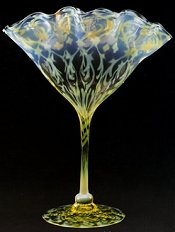 above: glass by John Walsh Walsh If you are looking for John Walsh Walsh Glass there is always some for sale on eBay. See what there is just now - click John Walsh Walsh Glass |
J Walsh Walsh Glass: A short explanation John Walsh Walsh bought a glassworks in Birmingham, England, in 1850 and it operated for a hundred years. The beautiful vase on the left is an example of this company's "New Opaline Brocade" glass which was advertised in the Pottery and Glass Trade Gazette in 1897. They made a large volume of glass, in all the typical styles of their period. Cut crystal in traditional or historical designs was another of their specialities, and from the turn of the century for the following 40 years they produced cut lead crystal with very deep cutting. In the early part of the twentieth century the John Walsh Walsh Glass factory continued to make traditional and Victorian types of glass, which were very popular with the British public. After the first world war (in 1923) the company became John Walsh Walsh Ltd (a public company) run by Philip and Sydney Walker (grandson's of John Walsh Walsh). The glassworks was by this time known as the Soho and Vesta Glass Works. In 1928 W G Riley (great grandson of John Walsh Walsh) took control of the operation, and during the 1930's the company produced some very modern designs. The glassware introduced by John Walsh Walsh Ltd in 1929 called "Pompeian" (a glass with random bubbles) was a major departure from their traditional production, and was very successful. They also introduced an irridescent range of blown glass in that same year. The designer/sculptor Walter Gilbert designed some beautiful lighting panels for John Walsh Walsh Ltd in 1930-1931. Another artist/designer, W. Clyne Farquharson, produced a set of designs for vases and bowls for the company between 1933 and 1937. These were advertised extensively in the Pottery and Glass Trades Gazette in the years 1936-37, and received a great deal of attention from the press and praise from the newly-formed Council for Art and Industry. Originally sold as signed, limited edition pieces, these vases were a major innovation in English pressed and engraved glass. From 1937 onwards the Farquharson designs were applied to a wider range of glassware, and the limited edition concept abandoned. All Farquharson designs are believed to be signed "Clyne Farquharson" and from 1939 onwards the letters NRD (Nationally Registered Designer) were added. Production of art glass and tableware at John Walsh Walsh ceased in 1942 because of the war in Europe, and was not restarted after the war. |